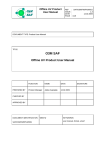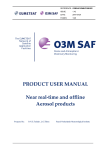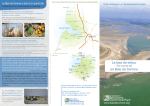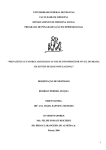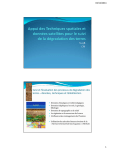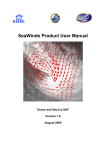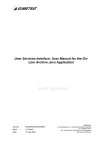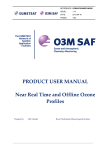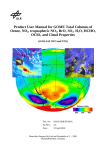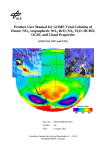Download PRODUCT USER MANUAL Offline UV (OUV) Products
Transcript
REFERENCE: ISSUE: DATE: PAGE: SAF/O3M/FMI/PUM/001 1.5 28.6.2013 1/ 16 PRODUCT USER MANUAL Offline UV (OUV) Products Prepared by: Jukka Kujanpää Finnish Meteorological Institute REFERENCE: ISSUE: DATE: PAGE: SAF/O3M/FMI/PUM/001 1.5 28.6.2013 2/ 16 Introduction to EUMETSAT Satellite Application Facility on Ozone and Atmospheric Chemistry Monitoring (O3M SAF) Background The need for atmospheric chemistry monitoring was first realized when severe loss of stratospheric ozone was detected over the Polar Regions. At the same time, increased levels of ultraviolet radiation were observed. Ultraviolet radiation is known to be dangerous to humans and animals (causing e.g. skin cancer, cataract, immune suppression) and having harmful effects on agriculture, forests and oceanic food chain. In addition, the global warming - besides affecting the atmospheric chemistry - also enhances the ozone depletion by cooling the stratosphere. Combined, these phenomena have immense effects on the whole planet. Therefore, monitoring the chemical composition of the atmosphere is a very important duty for EUMETSAT and the world-wide scientific community. Objectives The main objectives of the O3M SAF are to process, archive, validate and disseminate atmospheric composition products (O3 , NO2 , SO2 , OClO, HCHO, BrO, H2 O), aerosols and surface ultraviolet radiation utilising the satellites of EUMETSAT. The majority of the O3M SAF products are based on data from the GOME-2 spectrometer onboard MetOp-A satellite. Another important task of the O3M SAF is the research and development in radiative transfer modelling and inversion methods for obtaining long-term, high-quality atmospheric composition products from the satellite measurements. Product families • Near real-time Total Column (NTO) – O3 , NO2 , O3 Tropo, NO2 Tropo • Near real-time Ozone Profile (NOP) • Near real-time UV Index (NUV) • Offline Total Column (OTO) – O3 , NO2 , O3 Tropo, NO2 Tropo, SO2 , BrO, H2 O, HCHO, OClO • Offline Ozone Profile (OOP) • Offline Surface UV (OUV) • Aerosols (ARS) Product timeliness and dissemination Data products are divided in two categories depending on how quickly they are available to users: Near real-time products are available in less than three hours after measurement. These products are disseminated via EUMETCast (NTO, NOP), GTS (NTO, NOP) or Internet (NUV). Offline products are available in two weeks from the measurement and they are archived at the O3M SAF archives in Finnish Meteorological Institute (OOP, OUV, ARS) and German Aerospace Center (OTO). Only products with “pre-operational” or “operational” status are disseminated. Up-to-date status of the products and ordering info is available on the O3M SAF website. Information about the O3M SAF project, products and services: http://o3msaf.fmi.fi/ O3M SAF Helpdesk: [email protected] REFERENCE: ISSUE: DATE: PAGE: SAF/O3M/FMI/PUM/001 1.5 28.6.2013 3/ 16 DOCUMENT STATUS SHEET Issue Date Modified items / Reason for change 1.0 1.1 15.11.2006 04.05.2007 1.2 1.3 04.04.2008 12.02.2009 1.4 20.05.2013 1.5 28.06.2013 Initial revision of the full document -moved algorithm description and error analysis to a separate ATBD as required by EUMETSAT -updated the file naming convention -added error fields - clarified the setting of quality flags in section 3.2.; table 3 in section 5.1.2.; tables 7 and 8 in section 5.1.4. -added vitamin D weighting products -removed SCUP-h weighting products -introduced the homogenized cover page -added the SAF introduction page -renumbered tables and figures -reformatted tables - sect. 1.2: added acronyms - sect. 1.3.2.: corrected the HDF5 link - eq. 2.2: corrected O -> O(3P) - table 2.1: swapped wavelength ranges of UVA and UVB - p. 6: a HDF5 file -> an HDF5 file - p. 9: corrected typos, changed ’produced operatively’ -> ’operationally processed’, ’sending e-mail’ -> ’sending an email’ - sect 3.2.: rephrased the list on quality flag usage SAF/O3M/FMI/PUM/001 1.5 28.6.2013 4/ 16 REFERENCE: ISSUE: DATE: PAGE: Contents 1 INTRODUCTION 1.1 Purpose and scope . . . . . . . 1.2 Acronyms . . . . . . . . . . . 1.3 References . . . . . . . . . . . 1.3.1 Applicable Documents 1.3.2 Reference Documents . . . . . . . . . . . . . . . . . . . . . . . . . . . . . . . . . . . . . . . . . . . . . . . . . . . . . . . . . . . . . . . . . . . . . . . . . . . . . . . . . . . . . . . . . . . . . . . . . . . . . . . . . . . . . . . . . . . . . . . . . . . . . . . . . . . . . . . . . . . . . . . . . . . . . . . . . . . 5 5 5 5 5 5 2 Product overview 7 3 Product quality 3.1 Expected Accuracy and Validation . . . . . . . . . . . . . . . . . . . . . . . . . . . . . 3.2 Quality flags . . . . . . . . . . . . . . . . . . . . . . . . . . . . . . . . . . . . . . . . . 3.3 Current Quality Issues . . . . . . . . . . . . . . . . . . . . . . . . . . . . . . . . . . . 9 9 9 9 4 Processing, archiving and dissemination 4.1 Processing and archiving . . . . . . . . . . . . . . . . . . . . . . . . . . . . . . . . . . 4.2 Product ordering . . . . . . . . . . . . . . . . . . . . . . . . . . . . . . . . . . . . . . 4.3 User services . . . . . . . . . . . . . . . . . . . . . . . . . . . . . . . . . . . . . . . . 10 10 10 10 5 Product file format 5.1 File structure . . . . . . . . . . . . . . . . . . . . . 5.1.1 METADATA Group . . . . . . . . . . . . . 5.1.2 PRODUCT_SPECIFIC_METADATA Group 5.1.3 GRID_DESCRIPTION Group . . . . . . . . 5.1.4 GRID_PRODUCT Group . . . . . . . . . . 5.2 Data Types . . . . . . . . . . . . . . . . . . . . . . 5.3 File naming convention . . . . . . . . . . . . . . . . 11 11 11 12 12 12 15 15 . . . . . . . . . . . . . . . . . . . . . A Traceability of metadata to Eumetsat Data Centre parameters . . . . . . . . . . . . . . . . . . . . . . . . . . . . . . . . . . . . . . . . . . . . . . . . . . . . . . . . . . . . . . . . . . . . . . . . . . . . . . . . . . . . . . . . . . . . . . . . . . . . . . . . . . . . . . . . 16 REFERENCE: ISSUE: DATE: PAGE: 1 SAF/O3M/FMI/PUM/001 1.5 28.6.2013 5/ 16 INTRODUCTION 1.1 Purpose and scope This document is the user manual of the O3M SAF Offline UV product (OUV). It includes the definition of the product format. The algorithm and error analysis are described in a separate Algorithm Theoretical Basis Document [AD1]. 1.2 Acronyms ARS ATBD AVHRR CIE DLR DNA EUMETCast EUMETSAT FMI GOME-2 GTS HDF Internet Metop NOAA NOP NRT NTO NUV O3M SAF OOP OTO OUV PUM UMARF UV UVI WHO 1.3 1.3.1 Aerosol Retrieval System / Aerosol product Algorithm Theoretical Basis Document Advanced Very High Resolution Radiometer Commission Internationale de l’Éclairage, International Commission on Illumination Deutsches Zentrum für Luft- und Raumfahrt, German Aerospace Center Deoxyribonucleic acid EUMETSAT’s broadcast system for environmental data European Organisation for the Exploitation of Meteorological Satellites Finnish Meteorological Institute Global Ozone Monitoring Experiment-2 Global Telecommunications System Hierarchial Data Format International network Meteorological Operational satellite programme National Oceanic and Atmospheric Administration Near real-time Ozone Profile product Near real-time Near real-time Total Ozone product Near real-time UV product Satellite Application Facility on Ozone and Atmospheric Chemistry Monitoring Offline Ozone Profile product Offline Total Ozone product Offline UV product Product User Manual Unified Meteorological Archiving and Retrieval Facility Ultraviolet radiation UV Index World Health Organization References Applicable Documents [AD1] OUV Algorithm Theoretical Basis Document, SAF/O3M/FMI/ATBD/001, Issue 1.4, 28.6.2013. [AD2] O3M SAF Product Requirements Document, SAF/O3M/FMI/RQ/PRD/001, Issue 1.3, 16.5.2013. [AD3] UMARF to SAFs ICD, EUM/UMA/ICD/004, Issue 3.13, 14 Feb 2007. [AD4] UMARF SAF Metadata Definition, EUM/UMA/TEN/030, Issue 1.7, 09 Feb 2007. 1.3.2 Reference Documents [RD1] Global Solar UV Index: A Practical Guide, WHO, 2002, ISBN 92 4 159007 6, Annex C, http://www.who.int/uv/publications/en/GlobalUVI.pdf [RD2] McKinlay A.F and Diffey B.L., CIE Research Note, 6(1), 1987 [RD3] Setlow R.B., Proc. Nat. Acad. Sci. USA., 71, 3363-3366, 1974. [RD4] Caldwell, M.M. “Solar UV Irradiation and the Growth and Development of Higher Plants”, pages 131-177 in Giese A.G (ed.) Photophysiology, vol 6. Academic Press, New York, 1971 [RD5] CIE, 2006. Action spectrum for the production of previtamin D3 in human skin. Technical Report 174. International Commission on Illumination. [RD6] Kinne S. (2007): Towards an observation-tied AOD climatology, presentation in AT2 Aerosol Workshop, Bremen, June 2007. REFERENCE: ISSUE: DATE: PAGE: SAF/O3M/FMI/PUM/001 1.5 28.6.2013 6/ 16 [RD7] Tanskanen, A., (2004) Lambertian surface albedo climatology at 360 nm from TOMS data using moving time-window technique. Proc. XX Quadrennial Ozone Symposium, 1-8 June, Kos, Greece., pp 1159-1160. [RD8] HDF5 File Format Specification, http://www.hdfgroup.org/HDF5/doc/H5.format.html [RD9] Herman, J.R., and E. Celarier, “Earth surface reflectivity climatology at 340-380 nm from TOMS data.” J. Geophys. Res., 102, 28,00328,011, 1997. REFERENCE: ISSUE: DATE: PAGE: 2 SAF/O3M/FMI/PUM/001 1.5 28.6.2013 7/ 16 Product overview The O3M SAF offline surface UV product is derived from the measurements of the operational polar orbiting Metop and NOAA satellites. The product contains the most important quantities of the Sun’s radiation that can be harmful to life and materials on the Earth. These quantities include daily doses and maximum dose rates of integrated UV-B and UV-A radiation together with values obtained by different biological weighting functions, the solar noon UV index [RD1], and quality control flags. In addition, photolysis frequencies for photodissosiation of ozone and nitrogen dioxide are given for air quality applications. The product is calculated in a 0.5 degree regular grid and stored in an HDF5 file. The contents of the product file are listed in section 5. An example of the daily erythemal dose product is shown in figure 2.1 below. 0.0 0.8 1.6 2.4 3.2 4.0 4.8 5.6 6.4 7.2 8.0 Figure 2.1: An example product field. Erythemal (CIE) daily dose [kJ/m2] on 12 May 2008. The global coverage is limited by the swath of GOME-2 instrument, leaving stripes at low latitudes. The polar night and large solar zenith angles limit the coverage at the winter pole. The biological weighting functions (also known as action spectra) model responses of different biological entities to UV radiation. The currently applied functions are plotted in figure 2.2 (left) and a short description of their meaning is given in table 2.1. The photolysis frequencies jO(1 D) and jNO2 are the rate constants of the following two key reactions in the chemistry of the troposphere: O3 + hν(λ < 320nm) → O(1 D) + O2 , d[O(1 D)] = jO(1 D) [O3 ] dt (2.1) d[NO2 ] = jNO2 [NO2 ] (2.2) dt Absorption cross sections of ozone and nitrogen dioxide, and the quantum yields of the two reactions are shown in figure 2.2 (right). The photolysis frequencies are currently given only at the surface level. NO2 + hν(λ < 420nm) → NO + O(3 P), − Table 2.1: Description of the biological weighting functions used in the OUV product. Weighting function Ref. Integration wavelength range [nm] Description Measures the reddening of the skin due to sunburn. Also known as the erythemal weighting function. Used for UV index. Measures the ability of UV irradiance to cause damage to unprotected DNA. Measures the generalized response of plants to UV irradiance. Integrated UVB radiation Integrated UVA radiation production of previtamin D3 in human skin CIE [RD2] 290 - 400 DNA Plant UVB UVA Vitamin D [RD3] [RD4] [RD5] 290 - 400 290 - 400 290 - 315 315 - 400 290 - 330 REFERENCE: ISSUE: DATE: PAGE: 101 cross section [cm2 /molec] 100 relative response 2.0 1e 18 CIE DNA Plant vitD 10-1 10-2 10-3 absorption cross sections and quantum yields σ(O3 ), 298K σ(NO2 ), 298K 1.0 1.5 0.8 1.0 φ(O3 ), 298K 0.6 φ(NO2 ), 296K quantum yield 102 SAF/O3M/FMI/PUM/001 1.5 28.6.2013 8/ 16 0.4 0.5 0.2 10-4 10-5280 300 320 340 360 wavelength [nm] 380 400 0.0 300 350 400 wavelength [nm] 450 5000.0 Figure 2.2: Left: the biological weighting functions: CIE (blue), DNA (green), Plant (red) and vitamin D (cyan). Right: cross-sections (solid line) and quantum yields (dotted line) for ozone (blue) and NO2 (red). The key factors affecting the surface UV radiation are ozone, clouds, aerosols and surface albedo. The total ozone is obtained from the O3M SAF near real time total column ozone product (NTO). This product is made by German Aerospace Center (DLR) and disseminated via the EUMETCast broadcasting system. It is derived from the measurements of the GOME-2 instrument onboard Metop satellites. The cloud optical depth is estimated from AVHRR channel 1 (visible) reflectances. AVHRR is also onboard the Metop satellites. The sampling of the diurnal cloud cycle is improved by using additional AVHRR data from the NOAA satellites, available through the data exchange between EUMETSAT and NOAA. Because Metop is on a morning orbit and NOAA satellite on the afternoon orbit, at least two samples of the diurnal cycle can be obtained globally (fig. 2.3). More overpasses are available at high latitudes where the instrument swaths overlap for consecutive orbits. This sampling scheme provides a sufficient compromise between the global coverage and sampling of the diurnal cycle. Moreover, the processing data flow can be kept relatively simple because both the Metop and NOAA AVHRR data are available through EUMETCast. The aerosol optical depth is currently taken from a climatology [RD6], and the surface albedo from the climatologies of Tanskanen [RD7] and Herman et al. [RD9]. Metop 9:30 NOAA 14:30 Figure 2.3: The diurnal cycle of UV dose rate (clear-sky case shown for clarity) together with the sampling achieved by Metop and NOAA AVHRR measurements. The sampling of the diurnal cycle is improved at high latitudes where the instrument swaths overlap for consecutive orbits. REFERENCE: ISSUE: DATE: PAGE: 3 3.1 SAF/O3M/FMI/PUM/001 1.5 28.6.2013 9/ 16 Product quality Expected Accuracy and Validation The target product accuracy is 20 % against ground-based UV measurements. The surface UV product is validated by a validation service. This service, also located at FMI, performs two different validation activities. Firstly, online quality monitoring compares new products with a time-series of all previously processed products to detect any degration in the product quality. These online quality monitoring plots are available at http://o3msaf.fmi.fi/uv_validation/online_quality.html. Secondly, the UV product is fully validated against quality-checked ground-based measurements. These results are provided as validation reports. The latest validation report is available on the O3M SAF web site at http://o3msaf.fmi.fi/uv_validation/latest_report.html. 3.2 Quality flags Quality flags (table 5.6) are set during the processing to indicate degraded product quality. Figure 3.1 shows example plots of the quality flags. These quality flags should be carefully examined when using the product. In order to simplify basic quality control, three summary flags (table 5.7) have been designed: QC_MISSING, QC_LOW_QUALITY and QC_MEDIUM_QUALITY. The user is encouraged to use these summary flags as follows: • If invalid data is to be filtered out, apply QC_MISSING. This is also achieved by excluding fill values in the data. • If low data quality is to be filtered out, apply QC_LOW_QUALITY (it contains QC_MISSING). • If medium quality data is to be filtered out apply QC_MEDIUM (it contains QC_LOW_QUALITY). Figure 3.1: Example plots of the quality flags. The red color indicates where the flag is on. (left) The polar night flag is set when the solar zenith angle is larger than 88 degrees and (right) the low quality flag is set when it is larger than 70 degrees. The low quality flag is also set for other conditions, such as edges of ice sheets with inhomogeneous surface albedo and mountains with sloped surfaces. 3.3 Current Quality Issues The estimation of effective cloud optical depth from the AVHRR reflectances becomes prone to errors if the solar zenith angle is larger than 70 degrees or if the surface albedo is high, and therefore the corresponding product values are flagged as of low quality. The product values are also flagged if insufficient cloud data were available for the calculation of the diurnal integral. Climatological values are currently used for surface albedo and aerosols. The surface albedo climatology fails during snow falling and melting periods, which vary from year to year. The aerosol climatology, on the other hand, tends to underestimate the aerosol loading in the boundary layer, especially during the summer time. REFERENCE: ISSUE: DATE: PAGE: 4 4.1 SAF/O3M/FMI/PUM/001 1.5 28.6.2013 10/ 16 Processing, archiving and dissemination Processing and archiving The offline UV product is operationally processed with a maximum delay of 15 days between the satellite measurements and the dissemination to the users. The actual delay depends on the operational computing environment and on possible delays in getting the input data from different sources. The delay is typically three days. The overall processing scheme is described below. The input near real time total column ozone product (NTO) is produced by the German Aerospace Center (DLR). It is sent to the EUMETCast uplink station at Usingen, Germany, where it is broadcasted via telecommunication satellites (Eurobird). The NTO product is received at FMI, together with input AVHRR level 1b products both from Metop and NOAA satellites. The output OUV product is stored in the FMI Archive, from where it can be ordered via the Eumetsat Data Centre. The processing data flow is depicted in figure 4.1 below. Figure 4.1: Overall processing data flow. 4.2 Product ordering The product can be ordered from the Eumetsat Data Centre at http://www.eumetsat.int/Home/Main/DataAccess/EUMETSATDataCentre/index.htm. The product order will be transmitted to the FMI Archive, and the user will receive an e-mail containing the instructions on how to download the data files. 4.3 User services The helpdesk can be accessed through the O3M SAF web site at http://o3msaf.fmi.fi, or by sending an email to [email protected]. REFERENCE: ISSUE: DATE: PAGE: 5 SAF/O3M/FMI/PUM/001 1.5 28.6.2013 11/ 16 Product file format This section describes the HDF5 format [RD8] of the offline UV product. 5.1 File structure The data in the HDF5 file is organized under four groups: METADATA, PRODUCT_SPECIFIC_METADATA, GRID_DESCRIPTION and GRID_PRODUCT. The file structure is shown in figure 5.1. The values in all groups are either copied from the input data or calculated by the processor. The METADATA group contains the parameters required by the / METADATA PRODUCT_SPECIFIC_METADATA GRID_DESCRIPTION GRID_PRODUCT Figure 5.1: Structure of the HDF5 file. Eumetsat Data Centre while the PRODUCT_SPECIFIC_METADATA group is used for additional information specific to this product. The product fields are stored in a regular longitude-latitude grid. The grid parameters are stored as attributes of the GRID_DESCRIPTION group whereas the product fields are stored as datasets in the GRID_PRODUCT group. The x-dimension of the grid is the longitude and the y-dimension is the latitude. The product fields are two-dimensional arrays of floating point or integer data. If a value for a grid cell cannot be calculated, a fill value is written to the array. Each array has five attributes: Title, Unit, FillValue, ValidRangeMin and ValidRangeMax. These are used to describe the contents of the array. The organization of the data is illustrated in figure 5.2. YNumCells Latitude (y) XNumCells YStepDeg YStartLat Longitude (x) XStartLon XStepDeg Figure 5.2: Organization of the product fields in the HDF5 file. 5.1.1 METADATA Group The content of the METADATA group is shown in the following table. All parameters are stored as attributes of the group. The allowed values for the parameters that are required by the Eumetsat Data Centre are consistent with the requirements given in [AD4]. The allowed values given in italics mean any value of the given type (e.g. string means that the attribute can contain any string, within the size limit). SAF/O3M/FMI/PUM/001 1.5 28.6.2013 12/ 16 REFERENCE: ISSUE: DATE: PAGE: Table 5.1: METADATA group contents. Attribute name Data type Description Allowed values SatelliteID OrbitType InstrumentID SensingStartTime SensingEndTime ProcessingCentre ProcessingLevel ProcessingMode string string string string string string string string Platform identifier (mission and spacecraft the product originated from). Orbit type of the spacecraft, indicating the coverage of the product. Instrument which acquired the product. UTC date and time at acquisition start of the product. UTC date and time at acquisition end of the product. Centre that generated the data. Processing level applied for generation of the product. Processing mode applied for generation of the product ProcessingTime ReferenceTime ProductAlgorithmVersion ParentProducts BaseAlgorithmVersion ProductType ProductFormatVersion OverallQualityFlag QualityInformation DegradedRecordCount DegradedRecordPercentage MissingDataCount MissingDataPercentage GranuleType MapProjection DispositionMode string string string string string string string string string int int int int string string string UTC date and time at processing end of the product. Time at which the product is defined to be valid. Version of the algorithm that produced the product. A list of the name of the parent products, upon which the product is based. Version of the NTO product. Abbreviated name for the product type, or rather product category. Version number of the product format (= Issue of this User Manual document) Overall quality flag for the product. Several miscellaneous quality indicators for the product. Number of degraded product values. Percentage of degraded product values. Number of missing product values. Missing data percentage. Type description of the item. Projection used by the product Disposition mode applied for generation of the product M01,M02,M03, N15,N16,N17,N18, N19 etc. LEO GOME,AVHR YYYY-MM-DDThh:mm:ss.ddd YYYY-MM-DDThh:mm:ss.ddd O3FMI 03 N=Nominal, B=Backlogged, R=Reprocessed, V=Validation YYYY-MM-DDThh:mm:ss.ddd Same value as ProcessingTime String<4> NTO, AVHRR_level_1b String<4> O3MOUV String<4> OK or NOK String<511> Int Int 0-100 Int Int 0-100 DP Geographic O = Operational, P = Pre-operational 5.1.2 PRODUCT_SPECIFIC_METADATA Group The product specific metadata are listed in the following table. Table 5.2: PRODUCT_SPECIFIC_METADATA group contents. Attribute name Data type Unit Description LowSunNoonSza PolarNightNoonSza ThickCloudsCod HighAlbedoClearSky HighAlbedoClearSkyPatm InhomogeneousSurfaceHeightLimit InhomogeneousSurfaceAlbedoLimit float float float float float float float degree degree none none atm m none Limiting solar noon zenith angle for setting the QC_LOW_SUN quality flag. Limiting solar noon zenith angle for setting the QC_POLAR_NIGHT quality flag. Limiting cloud optical depth for setting the QC_THICK_CLOUDS quality flag. Limiting surface albedo for setting the QC_HIGHALB_CLEARSKY quality flag. Limiting surface pressure for setting the QC_HIGHALB_CLEARSKY quality flag. Limiting surface height deviation for setting the QC_INHOMG_SURFACE quality flag. Limiting surface albedo deviation for setting the QC_INHOMG_SURFACE quality flag. 5.1.3 GRID_DESCRIPTION Group The grid parameters are stored as attributes of the following table. GRID_DESCRIPTION group. The attributes are given in the Table 5.3: GRID_DESCRIPTION group contents. Attribute name Data type Unit Description XNumCells YNumCells XStartLon YStartLat XStepDeg YStepDeg int int float float float float N/A N/A degree degree degree degree Number of grid cells in the X direction Number of grid cells in the Y direction Longitude of the centre of the first grid cell in the X direction. Longitude ranges from -180 to +180. Latitude of the centre of the first gird cell in the Y direction. Latitude ranges from -90 to +90. Step (increment) between the grid cells in the X direction Step (increment) between the grid cells in the Y direction 5.1.4 GRID_PRODUCT Group The datasets in the GRID_PRODUCT group are given in the following table. The daily doses, daily maximum dose rates and their error estimates are stored for the following four different biological weightings: erythemal (“Cie”), DNA damage (“Dna”), generalized plant response (“Plant”) and vitamin D (“Vitd”), together with integrated UV-B (290-315 nm) and UV-A (315-400 nm) radiation and the solar noon UV index. In addition, the daily maximum photolysis frequencies of O(1 D) formation and NO2 photodissosiation are given. Attributes attached to all datasets in this group are listed in table 5.5. The contents of the QualityFlags and the setting of the summary flags are listed in tables 5.6 and 5.7. REFERENCE: ISSUE: DATE: PAGE: SAF/O3M/FMI/PUM/001 1.5 28.6.2013 13/ 16 Table 5.4: GRID_PRODUCT group contents. Dataset name Data type Unit Description DailyDoseCie DailyDoseCieLow DailyDoseCieHigh DailyDoseDna DailyDoseDnaLow DailyDoseDnaHigh DailyDosePlant DailyDosePlantLow DailyDosePlantHigh DailyDoseVitd DailyDoseVitdLow DailyDoseVitdHigh DailyDoseUvb DailyDoseUvbLow DailyDoseUvbHigh DailyDoseUva DailyDoseUvaLow DailyDoseUvaHigh DailyMaxDoseRateCie DailyMaxDoseRateCieLow DailyMaxDoseRateCieHigh DailyMaxDoseRateDna DailyMaxDoseRateDnaLow DailyMaxDoseRateDnaHigh DailyMaxDoseRatePlant DailyMaxDoseRatePlantLow DailyMaxDoseRatePlantHigh DailyMaxDoseRateVitd DailyMaxDoseRateVitdLow DailyMaxDoseRateVitdHigh DailyMaxDoseRateUvb DailyMaxDoseRateUvbLow DailyMaxDoseRateUvbHigh DailyMaxDoseRateUva DailyMaxDoseRateUvaLow DailyMaxDoseRateUvaHigh DailyMaxJO1D DailyMaxJO1DLow DailyMaxJO1DLow DailyMaxJNO2 DailyMaxJNO2Low DailyMaxJNO2Low SolarNoonUvIndex SolarNoonUvIndexLow SolarNoonUvIndexHigh QualityFlags float kJ/m2 float kJ/m2 float kJ/m2 float kJ/m2 float kJ/m2 float kJ/m2 float mW/m2 float mW/m2 float mW/m2 float mW/m2 float mW/m2 float mW/m2 float 1/s float 1/s float N/A int N/A Daily UV dose, CIE weighting -low dose estimate -high dose estimate Daily UV dose, DNA damage weighting -low dose estimate -high dose estimate Daily UV dose, Plant response weighting -low dose estimate -high dose estimate Daily UV dose, Vitamin D synthesis weighting -low dose estimate -high dose estimate Daily UV dose, integrated UV-B (290-315 nm) -low dose estimate -high dose estimate Daily UV dose, integrated UV-A (315-400 nm) -low dose estimate -high dose estimate Daily maximum dose rate, CIE weighting -low dose rate estimate -high dose rate estimate Daily maximum dose rate, DNA damage weighting -low dose rate estimate -high dose rate estimate Daily maximum dose rate, Plant response weighting -low dose rate estimate -high dose rate estimate Daily maximum dose rate, Vitamin D synthesis weighting -low dose rate estimate -high dose rate estimate Daily maximum dose rate, integrated UV-B (290-315 nm) -low dose rate estimate -high dose rate estimate Daily maximum dose rate, integrated UV-A (315-400 nm) -low dose rate estimate -high dose rate estimate Daily maximum j(O(1 D)) -low rate estimate -high rate estimate Daily maximum j(NO2 ) -low rate estimate -high rate estimate Solar noon UV index -low index estimate -high index estimate Quality flags for the product. See table 5.6 for interpretation of the bits. Table 5.5: Attributes for the GRID_PRODUCT group datasets. Attribute name Data type Description Title Unit FillValue ValidRangeMin ValidRangeMax string string same as the dataset same as the dataset same as the dataset Description of the dataset, e.g. “Solar noon UV index” Unit of the values in the array, e.g. second Number in the array, if actual data value is missing Minimum allowed value for the data in the array Maximum allowed value for the data in the array REFERENCE: ISSUE: DATE: PAGE: SAF/O3M/FMI/PUM/001 1.5 28.6.2013 14/ 16 Table 5.6: Interpretation of the QualityField. Flags have the value 1 for on and 0 for off. Bit Name Description 0 1 2 3 QC_MISSING QC_LOW_QUALITY QC_MEDIUM_QUALITY QC_INHOMOG_SURFACE 4 5 OC_POLAR_NIGHT QC_LOW_SUN 6 7 8 9 QC_OUTOFRANGE_INPUT QC_NO_CLOUD_DATA QC_POOR_DIURNAL_CLOUDS QC_THICK_CLOUDS 10 11 12 QC_ALB_CLIM_IN_DYN_REG QC_LUT_OVERFLOW QC_HIGHALB_CLEARSKY Data are missing. At most low quality expected. At most medium quality expected. The surface UV varies too much within the grid cell because of surface inhomogenity. The flag is set if: - surface height within the grid cell deviates from the mean value more than the value InhomogeneousSurfaceHeightLimit given in the product specific metadata field. - surface albedo within the grid cell and its nearby neighbours deviates more than the value InhomogeneousSurfaceAlbedoLimit given in the product specific metadata field. Polar night. The solar zenith angle is larger than the value PolarNightNoonSza given in the product specific metadata field. The Sun is too low for reliable radiative transfer modelling of surface UV. The threshold solar zenith angle is given in the LowSunNoonSza attribute of the product specific metadata field. Out of range input data was detected, but the value could still be used in processing. No cloud data were available. Poor diurnal cloud coverage. This flag is set when insufficient cloud data are available to cover the diurnal cloud cycle. Thick clouds were observed. This flag is set when optically thick clouds are observed during the day. Saturation of the atmospheric reflectance as a function of the cloud optical depth prevents accurate estimation of the cloud optical depth, and therefore, the surface UV flux cannot be accurately determined. The threshold cloud optical depth is given in the ThickCloudsCod attribute of the product specific metadata field. Surface albedo climatology was used in a dynamic region where albedo varies with the snow and ice cover. Look-up table limits were exceeded and a value was extrapolated. Clear-sky was assumed if surface albedo was larger than the value HighAlbedoClearSky and surface pressure was smaller than the value HighAlbedoClearSkyPatm given in the product specific metadata field. 13-15 16-19 reserved for future use QC_OZONE_SOURCE 20-23 24-27 28-31 QC_NUM_AM_COT QC_NUM_PM_COT QC_NOON_TO_COT 4 bits as an integer: source of total column ozone data. In the current version this is always 0 meaning GOME-2 total ozone (NTO or OTO) 4 bits as an integer: number of cloud optical thickness observations in the morning, value 15 indicating 15 or more observations. 4 bits as an integer: number of cloud optical thickness observations in the afternoon, value 15 indicating 15 or more observations. 4 bits as an integer: minimum time in hours (rounding towards zero) between the solar noon and the nearest cloud optical thickness (COT) observation Table 5.7: Mapping of the quality flags to summary flags. Summary flag Summary flag is on if any of these flags is on. QC_MISSING QC_POLAR_NIGHT QC_NO_CLOUD_DATA QC_MISSING QC_LOW_SUN QC_OUTOFRANGE_INPUT QC_LUT_OVERFLOW QC_LOW_QUALITY QC_POOR_DIURNAL_CLOUDS QC_HIGHALB_CLEARSKY QC_INHOMOG_SURFACE QC_THICK_CLOUDS QC_ALB_CLIM_IN_DYN_REG QC_LOW_QUALITY QC_MEDIUM_QUALITY REFERENCE: ISSUE: DATE: PAGE: 5.2 SAF/O3M/FMI/PUM/001 1.5 28.6.2013 15/ 16 Data Types The data types to be used in the HDF5 files are listed in the table 5.8 below. Table 5.8: Data types for the HDF5 files. 5.3 Data type HDF5 predefined data type char short int int float double string H5T_STD_I8LE H5T_STD_I16LE H5T_STD_I32LE H5T_IEEE_F32LE H5T_IEEE_F64LE Fortran: H5T_FORTRAN_S1, C: H5T_C_S1 File naming convention The file naming convention of the OUV product is depicted in figure 5.3. YYYYMMDDv01p00.HDF5 extension processor version, minor processor version, major day month year Figure 5.3: The structure of the OUV file name. REFERENCE: ISSUE: DATE: PAGE: A SAF/O3M/FMI/PUM/001 1.5 28.6.2013 16/ 16 Traceability of metadata to Eumetsat Data Centre parameters This appendix contains details related to the interface between the catalogue of the EUMETSAT Data Centre (previously named as UMARF, this acronym is used here for clarity) and the FMI archive [AD3]. The metadata parameters [AD4] which are applicable to the O3MSAF products are stored in the HDF5 file as attributes in the Metadata group (table 5.1). The tracing of UMARF parameters to the attributes in the product file is shown in table A.1 below. The attributes can only have values which are allowed by UMARF. Table A.1: Traceability of metadata to UMARF parameters UMARF Short Name Attribute Name Notes ASTI GORT LONS LONE LLAS LLOS LLAE LLOE LSVT OCSA OCLA OCLO OCTM AIID SMOD SSBT SSST ABID GNSP RRCC RRBT RRST PPRC PPDT PPST GPLV AVBA AVPA LMAP LSCD APXS SNIT AENV GDMD GPMD APNM APNA SatelliteID OrbitType N/A N/A N/A N/A N/A N/A N/A N/A N/A N/A N/A InstrumentID N/A SensingStartTime SensingEndTime N/A N/A N/A N/A N/A ProcessingCentre N/A ProcessingTime ProcessingLevel BaseAlgorithmVersion ProductAlgorithmVersion Map Projection N/A N/A ReferenceTime N/A Disposition Mode ProcessingMode ProductType N/A APPN APAS ParentProducts Added by Archive GNPO GNPF GNFV QCCV QQOV QQAI QDRC QDRP QDLC QDLP AARF N/A N/A ProductFormatVersion N/A OverallQualityFlag QualityInformation DegradedRecordCount DegradedRecordPercentage MissingDataCount MissingDataPercentage Added by Archive UUDT GGTP UDSP N/A GranuleType N/A Start Orbit Number End Orbit Number SubSatellitePointStartLat SubSatellitePointStartLon SubSatellitePointEndLat SubSatellitePointEndLon Ascending Node Crossing Date and Time Occultation Satellite ID (TBC) Occultation Latitude (TBC) Occultation Longitude (TBC) Occultation Date and Time (TBC) InstrumentMode Spectral Band IDs Number of Spectral Bands ReceivingCentre Reception Start Date and Time Ibid. End Date and Time Processing Start Date and Time Processing End Date and Time SpatialCoverageModel PixelSize SourceEnvironment Unique product identifier used in the O3M SAF archive; not included in the product file, provided to UMARF by archive software Product Actual Size; not included in the product file, provided to UMARF by archive software Native Pixel Order ProductFormatType Cloud Coverage Archive Facility; not included in the product file, provided to UMARF by archive software Ingestion Date and Time DispositionFlag, UMARF internal
















